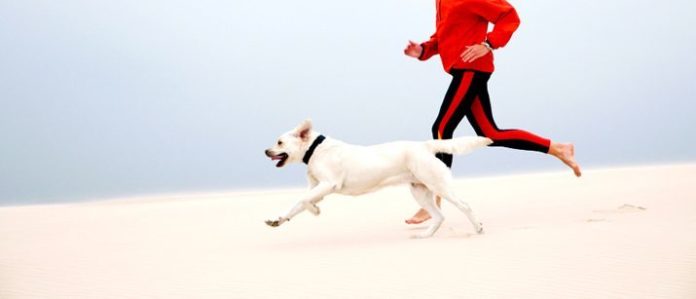An average of somewhere around 1 to 2 hours per day of exercise is right for the majority of dogs. But variables such as breed, age, and overall health make it necessary to tailor an exercise program to your dog’s specific needs.
Exercise is as important for your dog as it is for you. Ensuring your dog gets the right kinds of exercise will go a long way to keeping your dog in top shape.
It’s often said that dogs are a lot like people. That’s absolutely true – in more ways than one. A sedentary lifestyle is bad for people, and it’s bad for dogs too. Exercise can ward away illness and disease and keep your dog looking and feeling great. In fact, exercising your dog is so important that some animal welfare organizations have proposed laws requiring dog owners exercise their dogs on a daily basis. If you’d like to include your dog in your exercise routine, read our tips before starting a routine.
And just as there are proper and improper ways for you to exercise – the same is true for your dog. Planning a proper exercise program for your dog will help to ensure a long, happy and healthy life for your pet.
Walking
Walking is one of the healthiest and most effective forms of exercise, both for humans and canines. It’s also easy, enjoyable, and requires no special equipment.
And you’ll benefit just as much as your dog. In fact, you can consider dog walking to be one of the great perks of dog ownership. In 2008 the Health Promotion Journal of Australia reported that dog-owning families had only half the risk of childhood obesity compared to families without dogs. And researchers at the University of Western Australia have found that 70% of dog owners get at least 150 minutes of exercise every week, while only 40% of non-owners get an equivalent amount of exercise.
To get the best benefits of a walking program for both human and pet, plan on at least 30 minutes per day of walking. And try to make it a daily routine. If you walk at the same time every day, your dog will come to expect it. If you get lazy and try to slack off, your furry friend will give you a nudge!
Swimming
Dogs are natural swimmers; every dog is born with the instinctive ability to swim. But that doesn’t mean that your dog will like to swim. Some dogs are wary of water, while others (particularly of certain breeds) are drawn to the water.
If your dog likes to swim, be glad – it’s a great form of exercise. Swimming offers great aerobic conditioning, but without the impact stress of running. The low-impact exercise of swimming can be particularly beneficial for elderly dogs that may be suffering from arthritic joints.
Be careful, though, of where your dog swims. Lakes or ponds that exhibit lots of algae growth or dead fish floating on the surface may contain bacteria that could be harmful to your dog (and to you). And if your dog swims in a chlorinated pool, there’s a chance that the chlorine will irritate its skin. A quick rinse-off with a hose after swimming will eliminate that concern.
Interactive Activities
While the same can’t be said of people, for most dogs any type of exercise is fun. But if the exercise involves the dog’s best buddy (that would be you), the exercise is extra-special.
Activities like fetching a ball or Frisbee offer the benefits of great fun AND great exercise for your dog. These activities also offer great bonding opportunities, and can be just as an enjoyable experience for you.
Not Too Little, Not Too Much
Just like people, dogs can get too much of a good thing. But too little exercise is a bad thing. How do you know if you’re hitting the sweet spot with your dog’s exercise program? Watch for these indicators that your dog is getting too much or too little exercise.
Too Little
- A pudgy pooch
- Hyperactivity, including
- Excessive chewing
- Digging
- Barking
- Improper elimination can be related to lack of exercise
Too Much
- Your dog starts to lag during exercise, or suddenly stops to lie down
- Excessive panting, wheezing or shortness of breath
- Visible signs of distress or agitation
- Signs of lameness
Short-nosed breeds like pugs and bulldogs, for example, are far less tolerant of aerobic exercise (running, swimming, walking) than long-snouted breeds like retrievers and collies.
And just as the exercise needs of an 80-year-old human vastly differ from the needs of an 18-year-old, so too does the age of a dog affect its exercise needs. In general, an adult dog needs and tolerates more exercise than an elderly dog or a young pup.
Keep in mind that temporary factors such as a day’s heat and humidity can also impact the amount of exercise your dog can tolerate.
It’s Mostly Common Sense
Your dog is a unique individual, just as you are. So it’s important that you tailor an exercise program that’s suited specifically for your dog. Take into account your dog’s condition, too, when beginning an exercise program. If your dog is overweight or out of shape, it’s important to start slow and ease into the program gradually. It’s all about common sense.
Just Do It!
When it comes to exercising your dog it helps to remember the old Nike adage: ‘Just do it!’ A happy and healthy lifestyle awaits both you and your canine companion.









